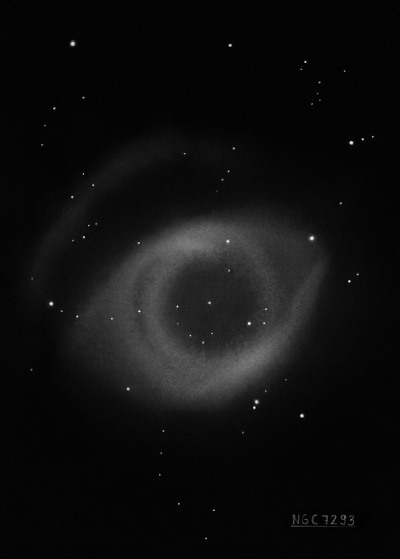Helix Nebula
Helix Nebula

15x50 IS binoculars (8/27/11): easily visible in binoculars using a pair of narrowband filters.
Karl Ludwig Harding discovered NGC 7293 = Au 48 around 1823-24 at Gottingen University Observatory, probably using an 8.5-inch reflector built by William Herschel. According to Wolfgang Steinicke, Harding published a list of 8 new nebulae in Astronomisches Jahrbuch, although the Helix Nebula is the only object he actually discovered, the others being observations of previously discovered nebuae. Harding's list was not checked until 1857 by Winnecke, so the Helix was not generally known. Ernesto Capocci independently discovered this huge planetary in late 1824 at Capodimonte Observatory in Naples, but his position was over a degree too far west and the object wasn't found or generally known by others. In 1856, Christian Peters reported another discovery while he was at Capodimonte Observatory around 1850 (AJ 2, p16). As late as 1884 Jermaine Porter also reported a discovery, although at that point it was already in the GC. Both Herschels missed finding this planetary, probably due to its large size.
Based on a September 1912 photograph (4 hour explosure) taken with the Crossley reflector at Lick, Heber Curtis wrote "I would suggest that this interesting object be referred to as "The Helical Nebula in Aquarius" [to distinguish it from the the Helical Nebula in Draco, NGC 6543]. In 1917, Robert Innes, at the Union Observatory in Johannesburg, noted it was "seen in both the 3-inch and 9-inch telescopes. Large, but no detail." and probably based on Curtis' comment, he referred to it as the "Helical nebula in Aquarius."
200/250mm - 8" (10/4/80): huge annular planetary is fairly bright at low power using a Daystar 300 filter. The rim has an irregular surface brightness.
300/350mm - 13.1" (8/15/82): the "Helix" nebula is extremely large, about 15' diameter, clearly annular. Significant contrast gain with OIII filter permits observation even from the Bay Area. The fairly bright rim is non-uniform appearing brighter along the north side. About seven stars are superimposed including the mag 13.5 central star. Appears best at low power due to size and relative low surface brightness. Easy in the 80mm finder.
400/500mm - 17.5" (10/2/99): gorgeous view at 100x and OIII filter. This huge, annular PN is 15'x12' in size and slightly elongated E-W due to an extension on the west side. The thick annulus is mottled and irregular with brighter regions along the N, NE and SW edge. The west side is slightly weaker but very faint extensions from the north and south side towards the west, cause the rim to bulge on this side (part of a second ring). The west edge of the halo more gradually blends into the background near a mag 11 star off the west side. At 220x without a filter about a dozen stars are superimposed. The mag 13.5 central star is easy along with a similar star a couple of arc minutes following.
Notes by Steve Gottlieb